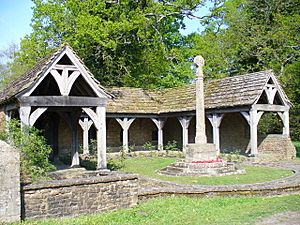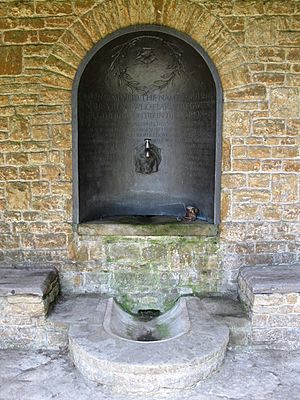Blackmoor War Memorial facts for kids
The Blackmoor War Memorial is a special place in Blackmoor, near Liss, in Hampshire. It was built to remember those who died in the First World War. This memorial is a cloister, which is like a covered walkway, and it stands on the north side of the main road. The Church of St Matthew is to its east, and the village school is to its west.
The memorial was designed by a famous architect named Sir Herbert Baker. It has three sides made of wood, open to the south, and it surrounds a grassy area with a memorial cross. Inside, you'll find several plaques and a fountain created by Sir Charles Wheeler. This memorial is considered very important, being one of about 130 Grade II* listed war memorials in England. This means it's a historically important building.
Contents
Why the Memorial Was Built
This memorial was asked for by a politician named William Palmer, 2nd Earl of Selborne and his wife, Maud Palmer, Countess of Selborne. They wanted to remember their second son, Captain Robert Stafford Arthur Palmer. He was 27 years old when he died in January 1916 from injuries he got during the First World War in a battle called Umm-el-Hanna. Captain Palmer was part of the 1/4th Battalion of the Hampshire Regiment. He is also remembered on the Basra Memorial in Iraq.
The Blackmoor War Memorial was officially opened in 1920. Sir Herbert Baker designed both the cloister and the cross. He later designed a similar memorial for Winchester College, called the Winchester College War Cloister. Both Robert Palmer and Baker's own sons went to school at Winchester College.
What the Memorial Looks Like
The Blackmoor War Memorial cloister has three sides. It stands behind and to the sides of a lawn, where a memorial cross is placed. The fourth side, facing south, is open. Steps lead up from the road to the memorial.
The covered walkway, or arcade, has a wooden frame that rests on walls made of Bargate stone. The roof is covered with Horsham stone. The floor inside the cloister is made of stone flags. Along the back wall (north side), there are benches on either side of a central fountain. This fountain has a lion's mouth spout and was meant to give drinking water to the children from the nearby village school. It was designed to bring "animation and lively activity" to a place remembering those who had died.
Memorial Plaques and Inscriptions
On the walls inside the cloister, there are six bronze memorial plaques made by Sir Charles Wheeler. Five of these are on the north wall (including the fountain), and one for Robert Palmer is on the east wall.
- Next to the fountain, there are two round plaques. One is about "War" and the other about "Peace," both decorated with symbolic trees.
- Another plaque is especially for the children of the village.
- Two plaques remember those who died in the First World War. One is for Captain Palmer, and another lists the names of 35 other people from nearby villages.
- Later, a plaque was added for 8 people who died in the Second World War.
- In 2009, another plaque was added with even more names that had been missed before.
The Memorial Cross
The memorial cross has a wheel-shaped head, which was a common design by Baker. It has eight sides and stands on an eight-sided base with three steps. The top of the cross has words carved into it: "TRULY THERE IS A GOD THAT JUDGETH THE EARTH." This is a quote from the end of Psalm 58 in the Bible.
Baker had suggested a similar cross design to the Imperial War Graves Commission (now called the Commonwealth War Graves Commission). However, they chose a different design by Sir Reginald Blomfield, which is the Cross of Sacrifice you see in many war cemeteries today. The Blackmoor cross stands on the lawn in the middle of the cloister, surrounded by a paved path.
Nearby Buildings
Close to the memorial are the village school and school house, which are Grade II listed. This means they are also historically important. The Church of St Matthew is also nearby and is Grade II* listed. Inside the church, there is a stone tablet listing 19 names from the First World War and a wooden board with 8 names from the Second World War. The church also has a special carved wooden plaque for Captain Palmer.
Recent History of the Memorial
The Blackmoor War Memorial was repaired and the fountain fixed in 2005. This work was paid for by the War Memorials Trust. In 2009, the Trust helped again to add a new plaque. This plaque listed names of people from both the First and Second World Wars that had been accidentally left off the earlier plaques. The restored memorial was officially rededicated in June 2010.
The Blackmoor War Memorial was first listed as a Grade II building in 1986. In May 2017, its status was upgraded to Grade II*. This happened as part of a project to recognize 15 memorials designed by Baker as a "national collection."



